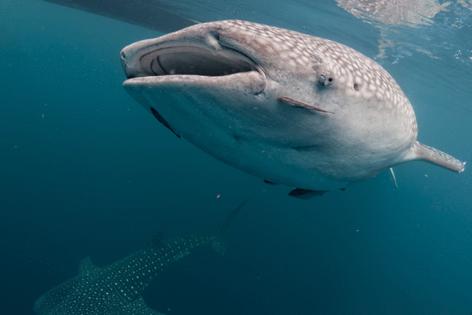As whale shark tourism booms, sharks suffer human-inflicted scars, study finds
Published in News & Features
The majority of whale sharks in a global tourism hotspot suffer from human-inflicted scarring, new research has revealed.
Between 2010 and 2023, a team of international scientists studied whale sharks — the largest fish species on Earth — in the Bird’s Head Seascape, a biodiverse region spanning some 86,000 square miles off the coast of Indonesia.
During their 13-year survey, researchers identified 268 individual whale sharks using spot patterns unique to each creature, according to a study published last week in the journal Frontiers in Marine Science.
Of the observed whales, 77% displayed scarring caused by human activity, while 58% had injuries attributed to natural causes, researchers said.
“We found that scars and injuries were mainly from anthropogenic causes, such as collisions with ‘bagans’ – traditional fishing platforms with lift nets – and whale shark-watching tour boats,” Edy Setyawan, one of the study authors, said in a news release.
“Relatively harmless minor abrasions were the most common,” Setyawan added. “Serious injuries from natural causes such as predator attacks, or from boat propellers were much less common.”
About 17% of the whales had major injuries such as lacerations from propellers, amputations or blunt trauma.
The vast majority of whale sharks observed were also young males, researchers said.
This is because younger males tend to prefer plankton-filled shallow waters, while females and sexually mature adults are typically found in the deeper ocean, preying on schooling fish.
Additionally, shark sightings were nearly entirely logged near bagans, which consist of a large net suspended from a floating wooden frame.
In addition to being used for fishing, these platforms are also associated with whale shark tourism — a booming industry in Indonesia. (A 2020 study found most marine tourists in Indonesia, 63%, prefer to see whale sharks above all other species).
“Given that the majority of the whale shark sightings occurred at bagans, and that whale shark tourism associated with these platforms is likely to continue growing, the risk of injuries from bagans and boats is expected to increase,” the study said.
In order to combat this, researchers suggested that a few simple modifications be made to bagans and boats, including removing sharp edges.
The study comes as global populations of whale sharks — which live in warm and tropical waters around the world — have declined substantially.
In the past 75 years, the worldwide population has dropped by 50%, while populations in the Indo-Pacific have fallen by up to 63%.
The species is classified as endangered by the IUCN.
In addition to Setyawan, the study authors were: Abdy W. Hasan, Yance Malaiholo, Abraham Sianipar, Ronald Mambrasar, Mark Meekan, Bronwyn Gillanders, Ben D’Antonio, Mochamad Putra and Mark Erdmann.
©2025 Miami Herald. Visit at miamiherald.com. Distributed by Tribune Content Agency, LLC.







Comments